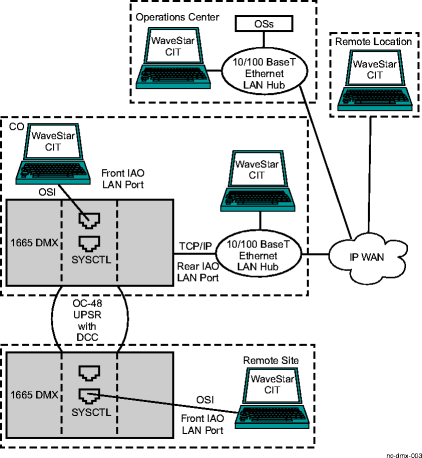IAO LAN ports (detail)
Overview
Alcatel-Lucent 1665 DMX supports a front and rear IAO LAN port. Each IAO LAN port operates independently (Alcatel-Lucent 1665 DMX does not support an internal IAO LAN hub). The front IAO LAN port is recommended for convenient, temporary local WaveStar® CIT access. When, for example, the WaveStar® CIT is directly connected to either IAO LAN port, a LAN crossover cable is required (to connect the transmit wire-pair at one end to the receive wire-pair at the other end, and vice versa).
The rear IAO LAN port is recommended for permanent local WaveStar® CIT access and all remote WaveStar® CIT access via TCP/IP as well as for OS access. Alcatel-Lucent 1665 DMX's rear IAO LAN port is typically expected to be connected to an Ethernet LAN hub in CO applications, but unused at remote sites.
The Alcatel-Lucent 1665 DMX IAO LAN ports support 10/100BaseT Ethernet (per Telcordia ® GR-253, ANSI/IEEE 802.2 and 802.3, and ISO 8802.2 and 8802.3) over four-wire twisted pair using an RJ-45 connector. Each IAO LAN port automatically adapts its rate to 10 Mb/s or 100 Mb/s to match the capability of the other nodes on the same IAO LAN, with 10 Mb/s as the default rate.
OSI on the IAO LAN
When the OSI protocol stack is used on an IAO LAN port, the term "OSI LAN" is sometimes used. The OSI LAN is effectively an extension of the DCC. All remote operations supported over the DCC are also supported over the OSI LAN. The term "DCC connectivity" is used throughout this document to mean DCC and/or OSI LAN connectivity.
OSI communications on the IAO LAN port can be enabled or disabled. By default, OSI is enabled on the front IAO LAN port, but disabled on the rear IAO LAN port.
TCP/IP on the IAO LAN
The IAO LAN ports also support the TCP/IP protocol stack. TCP/IP communications on the IAO LAN ports can be enabled or disabled. By default, TCP/IP is disabled on the IAO LAN ports.
When the TCP/IP protocol stack is used on an IAO LAN port, the term "TCP/IP LAN" is sometimes used.
Alcatel-Lucent 1665 DMX supports TL1 over TCP/IP for the IAO LAN. As a TL1 responder, the Alcatel-Lucent 1665 DMX TCP/IP GNE accepts incoming TL1 connections to the following TCP ports with corresponding TL1 code.
- Port 3081: Length-Value Encoding. With length-value encoding,each TL1 message is encapsulated into the TCP data stream as follows:
The length-value encoding is the preferred encoding for machine-machine interactions.
-
Port 3082: Raw Encoding. Each raw encoded TL1 message is encapsulated into the TCP data stream of length 1–4096 bytes. The TL1 message must be parsed to find the boundary between successive TL1 messages (see Telcordia ® GR-831 CORE for the syntax of TL1 messages).
-
Port 3083: Telnet Encoding. The telnet encoding is a variation on the raw encoding. It encapsulates TL1 messages in a TCP stream and uses Telnet for transmitting text over TCP/IP.
OSI or TCP/IP on the same IAO LAN
It is generally recommended that each IAO LAN port be used for OSI or TCP/IP, but not both protocols simultaneously on the same IAO LAN port.
The figure below provides examples of common applications using the IAO LAN ports.
Figure 5-3: IAO LAN port applications

IAO LAN compatibility
The following table documents the Alcatel-Lucent 1665 DMX IAO LAN communications compatibility with other products and the applicable OSI and/or TCP/IP protocol stacks. (WaveStar® CIT and OS access applications compatibility via the IAO LAN is covered separately later.)
Table 5-2: IAO LAN compatibility
|
Product |
Alcatel-Lucent 1665 DMX | |
|---|---|---|
|
OSI |
TCP/IP | |
|
Alcatel-Lucent 1665 DMX |
yes |
yes |
|
Alcatel-Lucent 1665 DMXplore |
yes |
yes |
|
Alcatel-Lucent 1665 DMXtend |
yes |
yes |
|
Alcatel-Lucent 1850 TSS-5 |
yes |
yes |
|
Alcatel-Lucent 1850 TSS-100 |
- |
yes |
|
Alcatel-Lucent 1850 TSS-320 |
- |
yes |
|
DDM-2000 OC-3 |
yes |
- |
|
DDM-2000 OC-12 |
yes |
- |
|
FiberReach |
- |
- |
|
FT-2000 ADR |
- |
- |
|
WaveStar® TDM 2.5G/10G (2-Fiber) |
yes |
yes |
|
WaveStar® BandWidth Manager |
yes |
yes |
|
Alcatel-Lucent 1675 LambdaUnite MSS |
yes |
yes |
|
WaveStar® CIT |
yes |
yes |
|
OMS |
yes |
yes |